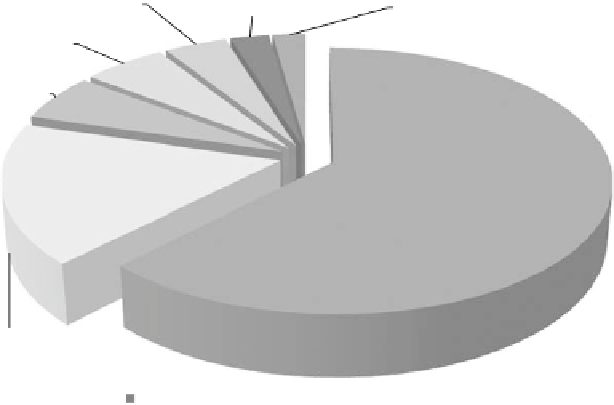Environmental Engineering Reference
In-Depth Information
Table 10.1 for definitions of vehicle classifications for light-duty applications (trucks and passenger
vehicles) and heavy-duty engines (U.S. DOT RITA 2010). Diesel engines are characterized as hav-
ing a higher efficiency, with a peak of 45% (U.S. DOE 2010a), but are hampered by high engine-out
particulate matter (PM) and oxides of nitrogen (NO + NO
2
= NO
x
) emissions, which require com-
plex exhaust aftertreatment systems to meet emissions standards.There are many places that energy
is “lost” from the vehicle as an automobile travels down the road. A summary of these losses, as a
percentage of the fuel's total energy, is shown in Figure 10.1 (U.S. DOE and EPA 2008), where it is
seen that the most losses originate from the engine. Current LDV hybrid electric vehicles (HEVs)
(e.g., Toyota Prius, and hybrid versions of the Ford Escape and Chevy Tahoe) include on-board
storage of electrical energy and electric drives, yet still derive nearly all required energy for vehicle
operation from the combustion of fuel in the on-board IC engine. However, HEVs are designed to
reduce the losses in several of the areas shown in Figure 10.1. HEVs achieve reductions in energy
consumption by permitting the vehicle system to manage power requirements such that the IC
engine is operated near its peak efficiency more frequently than a nonhybrid powertrain (targeting
the engine losses), including allowing the engine to be shut off when not needed on decelerations
and when the vehicle is stopped (targeting the idle losses). Additionally, hybrid electric systems are
able to recapture kinetic and potential energy when a vehicle is stopping or descending a hill (target-
ing the braking losses). This energy, which would otherwise be lost to heat in the friction brakes,
taBle 10.1
vehicle categories used in standards
Gross vehicle Weight rating (GvWr)
Passenger vehicle
classifications
light-duty truck
classifications
heavy-duty engine
classifications
category
Light
8500 to 19,500 lb
<8500 lb
<6000 lb
Medium
8500-10,000 lbs
19,500 to 33,000 lb
Heavy
6000-8500 lb
>33,000 lb
Aerodynamic drag,
2.6%
Rolling resistance,
4.2%
Accessories, 2.2%
Drivetrain losses,
5.6%
Braking, 5.8%
Idle, 17.2%
Engine losses, 62.4%
FIGure 10.1
The losses in a typical LDV shown as a percentage of the fuel's total energy, assuming an SI
engine. (From U.S. DOE and EPA, Advanced technologies & energy efficiency, 2008.)









